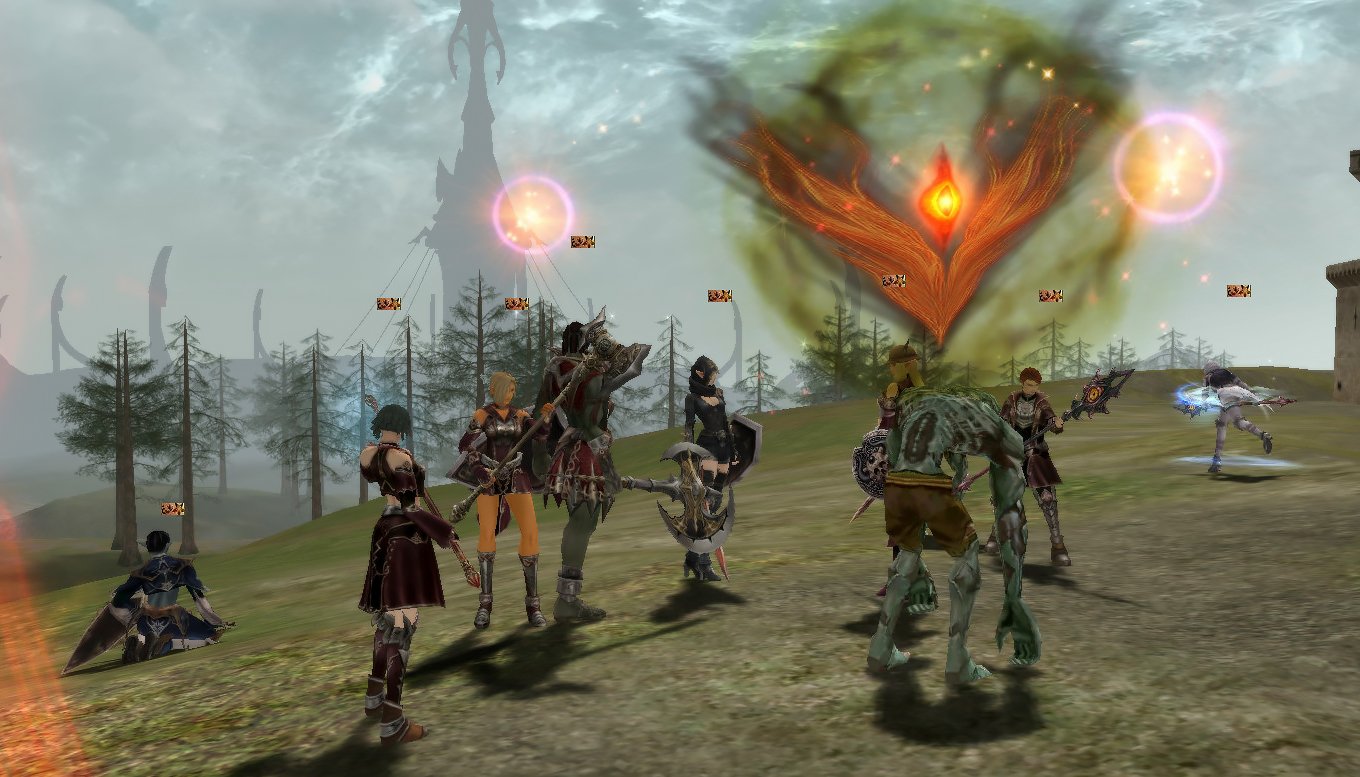
For MMO players, Improbable brought some interesting ideas to GDC this past spring. It also brought some games I wasn’t expecting, and the ones I was expecting were kind of downplayed. On the ground floor, developers from some of our favorite MMOs hadn’t heard of SpatialOS, a platform that allows games to be “bigger” by running multiple game engines in an innovative way, with a few developers being exceptions. I was set up for a meeting with Improbable CCO Bill Roper to help figure things out, but soon into our physical meeting he was pulled away and we had to follow up with emails, which rarely goes as well.
Fortunately, Roper had time to sit and chat again with me at E3. With SpatialOS’s first game out in the wild and more on the way, I felt like there was a lot Roper could explain about SpatialOS, MMOs, and Improbable’s role in it all.
Billion-person gaming vs. singleplayer
One of the things that’s certainly hard for even developers to grasp is what SpatialOS does. While I’ve previously explained that (in short) it acts as a kind of manager between the gameworld and the engines running it, that explanation doesn’t always make a huge impact. Improbable’s Survival demo (above) had an image of “Inspector,” a tool that can be used to show developers what Spatial is tracking across its multiple collections of game engines, next to it during GDC, which certainly helped me get an idea of what Spatial was capable of in practice. In fact, Roper says he’d underestimated Inspector’s potential impact. Numbers help people understand new concepts, but more visuals aided too.
But then you have to reach players. While Survival was built for a specific task, it hasn’t really worked on consumers. If you’re told a game can hold a thousand players, for an MMO player, that sounds normal. If we say that the game holds a thousand people in a 1km by 1km room, some people will have a better idea of what that means. But for your average gamer, whose gaming experience often has them slaughtering what feels like hundreds of NPCs at a time, it doesn’t do much. The player isn’t big on game tech, and as Roper notes, that tech often works well because it masks developer limitations behind a veil of smoke and mirrors. It’s no one’s fault the player is ignorant of this, but it is a fact.
During my hands-on last month, I spent a lot of effort trying to explain why Worlds Adrift simply can’t be a PvE-only game without making a lot of sweeping changes. Often, even logical explanations essentially amounted to building a completely different game that lacked all the things that from a critical perspective make Worlds Adrift stand out, especially in terms of tech. Getting players to understand that is hard, and while Roper wants to tackle it, he admits that aside from continued exposure to those sorts of games, a new demo is required to do that (and may need to be developed).
To put things in perspective, Frostkeep’s Jeremy Wood mentioned at GDC that SpatialOS wasn’t quite ready for the MMO sphere. When I asked about physics-based damage from falling debris in this year’s E3 Rend demo, both Wood and co-founder Solomon Lee said their engine couldn’t handle that kind of tracking. Wood and Lee are clear that it’s not that it’s impossible, since World’s Adrift does it, but that it does require sacrificing things like mob spawns and AI, which a PvE player clearly wouldn’t want to do.
Roper told me that players probably don’t grok how big a technical issue some of these advancements are because game developers are good at masking them – for example, a battlefield may seem to host thousands of players when there’s actually only 50 on your screen being phased in at a time.
What’s worse, perhaps, is that there’s no easy way to change this. Players simply need to experience the real deal for themselves and see how different it is compared to more traditional games. At least in my mind, though, the “problem” with MMOs is that they’ve increasingly been billed as themeparks thanks to the popularity of World of Warcraft and more modern developer-driven storytelling tools a la Final Fantasy XIV and Elder Scrolls Online.
I’m not saying any of this is bad, but remember that we often talk about MMORPGs. We’ve talked about, academically, games starting out as simulations, especially our genre. The MMO sprung from the MUD, which is what gave birth to the single player RPGs. While the singleplayer RPG allowed the player to explore the world in a very controlled narrative, early MMOs (especially sandboxes) were much more and shared.
We’ve spoken about what virtual worlds are in the past and how to use Raph Koster’s definition to assess what may or may not be one, but it’s messy. That being said, one of the main criteria was that the virtual world needed an environment that led to “player to player interaction.” That can mean PvP, but not wholly in a way you might think.
More than a PvP platform
One of the big things Roper and I discussed was how Spatial seems to be housing PvP games: Worlds Adrift, Mavericks, Scavengers… the list goes on. I can understand why many of our PvE readers don’t seem impressed with the games being developed on Spatial!
A big part of this is that SpatialOS isn’t just for games. Improbable’s actually helped even the British and US government construct city simulations, aimed at predicting which systems will fail, in what order, and from what cause if, say, a single city block goes dark. The ability to track multiple objects is a huge tech advancement, and not one limited to being used for games.
Let that sink in for a moment. Spatial isn’t just for video games. It is legitimately creating virtual worlds to help real-world entities explore possibilities. I hate to sound elitist, but to reduce our genre to loot farming and interactive movies is like using a hammer only as a can opener. And I’m not just referring to players stripping deep gaming designs of power to innovate but to designers who just try to create the same simple gameplay times two.
While many SpatialOS games are PvP-oriented, Roper brought up upcoming MMO Seed, saying it’s “mostly” a PvE game, so PvE fans can hopefully jump into that and see how tracking thousands of objects in a shared world makes a game functionally different. That being said, we know making weapons is possible, but basic gameplay, in theory, is more culture-based.
You have your own colony of organisms that are growing into “humans” and you’re always logged in, but the idea is that you’re juggling how your colony’s culture deals with others. You may be hostile towards your neighbor when you’re logged in, but your colony may try to make peace with the “enemy” when you’re not at the keyboard.
As always, everything works well in theory. I’d argue many PvE players probably enjoy economic PvP, achievement comparisons, maybe even social PvP. The problem in my mind, though, is creating a type of PvP that challenges the player without driving him off.
Even Roper notes that in open world games that allow for PvP, griefers always come first. They swarm in, test the limits of the virtual society, but then they often wander off. Much as in my Sea of Thieves experience, waiting for post-launch pirates to burn out before jumping in probably greatly increased my enjoyment of the game (and is the reason I’d like to give Worlds Adrift a second shake at one point).
The issue, however, is not that Improbable is making these games; it’s that SpatialOS is more suitable to be building the next generation of them. While Improbable has veteran designers to help guide developers, Roper notes that the PvP/PvE issues are the ones for the game developers themselves to tackle. Much like the playground, the tone is set by whoever runs it, not necessarily the guy that built the sandbox.

Making sense to developers
One of the big issues we talked about previously is how a developer can’t just look at Improbable’s pricing page and see the cost. Having to have a discussion with a vendor before getting a quote in my mind means I’m about to be asked to pay an extraordinary amount of money.
The cash issue can now slightly be solved with test tools for Spatial, giving potential customers an idea of how much what they’re building may cost. However, Roper says Improbable doesn’t just try to take your money. Because they have experienced developers and a department specifically for working with outsiders, they can explain how the system can take what they’re doing, relay how much it’ll cost them, and suggest ways the design could be modified to reach that goal in a more affordable manner.
In fact, this is exactly how they helped the Worlds Adrift team. It’s why Bossa’s launch wasn’t just a celebration that Spatial was out in the wild; it was because a team Improbable had been helping launched its project.
Going back to the PvP games perspective, Roper says what developers like about PvP games, especially open, persistent PvP worlds, is that they allow players to be “expressive.” It allows emergent play.
Now, you do have this in PvE games too you may say. I’d argue a good one is Animal Crossing. No combat, free form pattern designing, fishing, gardening, museum curation, home customization and decoration… the epitome of what I’d argue a PvE sandbox fan would like.
But as someone who ran an Animal Crossing neighborhood watch within a fan community, I can tell you that PvP still happened. Griefers (often children), would steal anything not bolted to the floor. They’d (accidentally?) destroy rare flowers that take days to create, write vulgar letters to townsfolk who would show them to any player engaged with them, and chop down forests, making someone’s beautiful orchard a wasteland.
 And Animal Crossing’s limited online play makes fans hungry for bigger, more persistent experiences, even if they hate the griefers. As cute as it is, you can have a sort of PvP experience in Animal Crossing because the same freedoms that allow players to help each other allow them to hurt each other. Again, remember what Roper said about smoke and mirrors. Those games that may “seem” to offer the same kind of experience Animal Crossing does in a “safer” environment are probably faking it.
And Animal Crossing’s limited online play makes fans hungry for bigger, more persistent experiences, even if they hate the griefers. As cute as it is, you can have a sort of PvP experience in Animal Crossing because the same freedoms that allow players to help each other allow them to hurt each other. Again, remember what Roper said about smoke and mirrors. Those games that may “seem” to offer the same kind of experience Animal Crossing does in a “safer” environment are probably faking it.
This is because Roper also mentions how simulation fits into the equation. In good virtual worlds, you’re pulling more from your real-world knowledge. For example, Roper notes how a player named Anne in Worlds Adrift lost her character skills after a certain wipe, but realized she didn’t necessarily need to regain them. She could get things done through trade. Instead of building an airship, she basically made a shop, even though there’s no specific schematic to do that or a system for housing. While anyone can come in, gank her, and tear her building down, it’s not something that ruins her experience. She’s built a reputation with players who protect her and she even expanded her services to incorporate travel and protection services.
It’s more reality-based, but a reality where you need to survive. Think about all the different ways animals use our garbage, from bottle caps as homes for crabs to birds using cigarettes as pesticides. If these animals were pets, they’d never learn these skills. Survival is the responsibility of the keeper. In a PvE setting, the player is essentially the pet. Now, to be fair, being a pet wouldn’t be so bad if you’ve got a nice owner. However, finding that kind of safety in the wild is rare, so it’s understandable if some people were to choose safety over freedom, especially in their hobby.
That being said, even Roper admits that that sort of freedom doesn’t have to originate from overt PvP. Upcoming game Scavengers is a PvE game in theory, but is PvPvE in practice, as it’s, well, basically The Division’s Darkzone as a game.
While I don’t think Roper and I discussed any panacea for making players “get” SpatialOS, for developers to go beyond Gankbox 2.0 or even how to make the best use of virtual worlds for gamers, I was satisfied with pragmatic responses, such as these issues requiring public exposure to help people grapple with them. The more I talk to Roper, the more he shows that he’s not just a figurehead at Improbable; he continues to be a developer grounded in game design, capable of supporting and advising his fellow devs. SpatialOS may not be perfect, but it’s made virtual worlds a much more solid reality. We just need to figure out what that means for our genre, as both players and game developers.

















